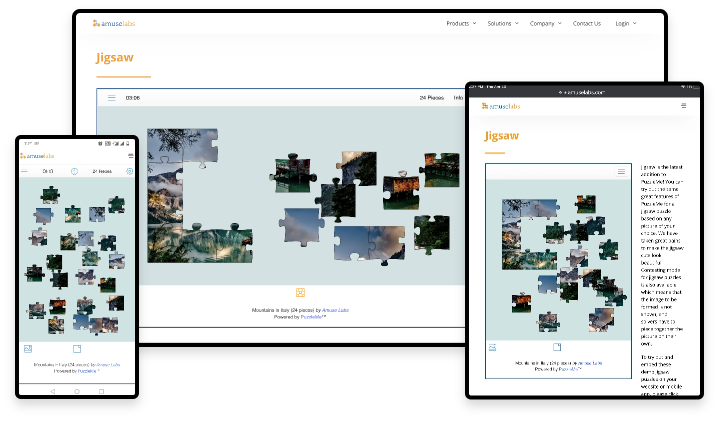If you love jigsaw puzzles and want to share your passion with the world you’re not alone. Whether you’re a collector, a solver, or a puzzle-making enthusiast, starting a jigsaw puzzle blog is the perfect way to connect with like-minded people and build a community around your favorite pastime.
Why now? Because niche blogs are thriving. r/Jigsawpuzzles on Reddit already has 90k+ subscribers. More and more readers are looking for specialized content that speaks directly to their interests — especially in areas like hobbies, games, and puzzles. That means your unique voice and puzzle expertise could find a welcoming, engaged audience faster than you think.
In this post, we’ll walk you through everything you need to start your own jigsaw puzzle blog.
Bonus: We’ll also show you how to make your blog interactive with fun tools like PuzzleMe, so your readers can play along with your posts. Let’s get started!
🧩 Step 1: Define Your Jigsaw Puzzle Blog Niche
Before diving into blog design or content planning, it’s important to define your niche — the specific angle or theme your jigsaw puzzle blog will focus on. Picking a clear direction not only helps you stand out but also attracts a loyal, engaged audience.
🎯 Decide Your Focus
There are many creative ways to approach jigsaw puzzles on a blog. Here are a few niche ideas to consider:
Puzzle Reviews
Share your thoughts on different puzzle brands, themes, materials, piece quality, and difficulty levels. Think of it as the go-to guide for fellow enthusiasts looking for their next purchase or play. Read & get inspiration from the NY Times.
DIY Puzzle Tutorials
Walk readers through how to create their own jigsaw puzzles at home — whether it’s using craft supplies, digital tools, or printable templates. Here is a video tutorial on making a DIY jigsaw.
Puzzle-Solving Techniques
Offer tips and tricks on how to sort pieces, identify patterns, and improve speed and accuracy, making it perfect for competitive solvers or curious beginners.
Interactive Puzzles
Curate or create puzzles that visitors can download or solve online. This niche pairs well with tools like PuzzleMe for interactive content. Here is a quick tutorial to make an interactive jigsaw puzzle online!
Educational or Therapeutic Use of Puzzles
Explore how puzzles can support child development, cognitive skills, mindfulness, or even occupational therapy. Great for parents, teachers, and health professionals.
🔍 Research Your Audience
Once you choose a direction, think about who you’re speaking to. Common audiences for jigsaw puzzle blogs include:
- Casual solvers looking for fun, relaxing puzzle recommendations
- Parents seeking screen-free activities for kids
- Educators incorporating puzzles into lesson plans
- Competitive puzzlers aiming to improve their skills
- Therapists and professionals using puzzles in their work
Understanding your readers helps you shape your content, tone, and features (like downloadable PDFs or embeddable puzzles).
💡 Pick a Memorable Blog Name
Your blog name is your brand — make it relevant, catchy, and easy to remember. It could reference your niche, personality, or the puzzling process itself. Try a puzzle pun, a calming vibe, or a name that signals authority in the space.
Inspiration from existing blogs:
- My Jigsaw Journal – A personal diary-style blog chronicling puzzle journeys
- Jigsaw Puzzle Talk – A community-centric blog that suggests discussion and tips
Take a moment to check domain availability, social handles, and see how your name looks visually, You’ll be building your brand around it!
🧩 Step 2: Set Up Your Blog Platform
Once you’ve chosen your niche and blog name, it’s time to build your online home. Don’t worry — you don’t need to be a web developer. With today’s blogging platforms, setting up a professional-looking site is easier than ever.
Choose a Blogging Platform
Your platform is where your blog lives. It’s the engine behind everything readers see and interact with. Here are some beginner-friendly options:
- WordPress (Recommended): Offers full control, thousands of plugins, and great scalability.
- Wix: A drag-and-drop builder with stylish templates. Good for visual bloggers who want quick setup and minimal tech headaches.
- Squarespace: Sleek and all-in-one, with beautiful templates and hosting included. Ideal if you prioritize design and simplicity.
Pro Tip: If you plan to embed interactive puzzles (like those created with PuzzleMe), make sure your platform allows HTML or iframe embedding. All the mentioned platforms allow this.
Get a Domain Name
Your domain is your blog’s address — like www.mypuzzlename.com. Choose something that reflects your niche and is easy to remember. Try to include relevant keywords like: Puzzle, jigsaw, games, solving, pieces. Use tools like Namecheap or GoDaddy to search domain availability, and aim for a .com extension if possible.
Choose a Clean, Responsive Theme
 A good theme keeps your blog easy to read and pleasant to navigate — especially on mobile.
A good theme keeps your blog easy to read and pleasant to navigate — especially on mobile.
Look for a theme that’s:
- Clean and uncluttered
- Mobile-responsive (works on all screen sizes)
- Easy to customize (fonts, colors, layout)
- Compatible with your platform and plugins
Bonus if it comes with built-in blog templates and space for images or embedded puzzles!
Add Essential Plugins or Features
To grow and manage your blog smoothly, install a few core tools (especially if you’re using WordPress):
- PuzzleMe WordPress Plugin – It allows you to quickly embed puzzles and pickers into your WordPress website. The plugin allows you to unlock additional features, such as social sharing and multiplayer.
- SEO Plugin (like Yoast SEO or Rank Math) – Helps your posts rank better on Google
- Contact Form Plugin – Let readers reach out or submit ideas
- Newsletter Signup Form – Start building an email list from day one
- Analytics – Track your traffic with tools like Google Analytics or Jetpack
🧩 Step 3: Plan Your Content Strategy
Comment
byu/SmythOSInfo from discussion
inSocialMediaMarketing
A successful blog isn’t just about writing — it’s about writing consistently and strategically. Whether you’re a casual puzzler or aiming to grow an audience, a solid content plan helps keep your blog active and discoverable.
Not sure what to write about? Here are some puzzle-friendly post ideas your audience will love:
- Top 10 Jigsaw Puzzles for Beginners: Great for readers just getting started with the hobby.
- Printable Puzzle of the Week: Offer downloadable puzzles to build a habit with your readers.
- Why Jigsaw Puzzles Are Great for Mental Health: Combine research and storytelling to explore the therapeutic benefits of puzzling.
- Interview with a Puzzle Designer: Bring in unique voices and behind-the-scenes insights.
These ideas can be customized based on your niche — whether you’re reviewing puzzles, creating your own, or exploring the psychology behind them.
Create a Content Calendar
Consistency is key. Plan your posts in advance using a simple spreadsheet or a content planning tool like Trello, Notion, or Google Calendar. Try to publish at least once a week or biweekly to build momentum.
- Schedule evergreen content that stays relevant year-round (e.g., “Best Sorting Strategies for 1000-Piece Puzzles”)
- Mix in seasonal or trending topics, like gift guides, puzzle challenges for holidays, or new puzzle releases
This balanced approach ensures your puzzle blog stays fresh and relevant throughout the year.
🧩 Step 4: Make Your Jigsaw Puzzle Blog Interactive
Want to make your puzzle blog stand out? Don’t just write about puzzles — let your readers solve them right on your site. Add Embeddable Puzzles with PuzzleMe.
Using a tool like PuzzleMe, you can embed interactive jigsaw puzzles directly into your blog. All your readers need to do is click and play — no downloads required. Try now:
Adding a PuzzleMe embed takes seconds and instantly boosts engagement. Adding interactive content not only makes your blog more fun — it also increases traffic, return visits, and word-of-mouth growth. When publishers like Scientific American use PuzzleMe’s interactive jigsaw puzzles, you know it is worth it!
🧩 Step 5: Build an Audience
Once your jigsaw puzzle blog is up and running, it’s time to bring in readers.
- Leverage social media – Share puzzle photos, tips, and blog updates on Instagram, Pinterest, and in Facebook Groups dedicated to puzzle lovers.
- Engage in communities – Join forums like Reddit’s r/Jigsawpuzzles or local puzzle clubs to connect with fellow enthusiasts.
- Start a newsletter – Offer bonus puzzles or exclusive content to grow a loyal subscriber base. PuzzleBuzz is a great example!
- Collaborate with brands – Reach out to puzzle companies for guest posts, interviews, or giveaways to expand your reach.
🧩 Step 6: Monetize Your Blog
Ready to turn your puzzle passion into profit? Here are a few ways to monetize:
- Affiliate marketing – Recommend puzzle products and earn commissions via Amazon or puzzle brand affiliate programs.
- Ad revenue – Use platforms like Google AdSense or Mediavine once you have steady traffic.
- Sell your own puzzles – Create and sell digital or printable puzzles. Once you have a following, you can put special puzzles behind a paywall.
- Launch merch – Offer puzzle-themed mugs, posters, or t-shirts through print-on-demand sites.
- Host events – Run online puzzle challenges or virtual game nights for your community.
🧩 Step 7: Use PuzzleMe to Create Custom Puzzle Content
Once your puzzle blog is up and running, you’ll want ways to keep readers engaged. That’s where PuzzleMe comes in — a powerful, flexible platform designed for creating and embedding custom puzzles right into your site.
 Why PuzzleMe?
Why PuzzleMe?
Whether you’re running a casual jigsaw puzzle blog or building a puzzle brand, PuzzleMe offers tools that bring your content to life:
- Create interactive jigsaw puzzles, crosswords, sudoku, and word searches
- Mobile-friendly UI for smooth solving on any device
- Multilingual support — perfect for global audiences
- Easy embedding with a simple copy-paste HTML snippet (Read- No coding required)
- Fully customizable — decide number, shape, and time of your jigsaw puzzle.
Example Use Case:
“Puzzle of the Week” Offer your readers a weekly interactive puzzle challenge directly on your blog — no sign-ups, no downloads, just instant play. PuzzleMe makes it easy to turn your images or ideas into playable puzzles in minutes.
Starting a puzzle blog is fun, rewarding, and a great way to connect with fellow enthusiasts. Whether you’re sharing reviews, printable puzzles, or interactive games, your blog can become a go-to destination for puzzlers around the world.
- How to Start Your Own Jigsaw Puzzle Blog - April 16, 2025
- How to Host a Jigsaw Puzzle Competition Online - March 20, 2025
- Add Games to Squarespace: All You Need to Know - January 9, 2025